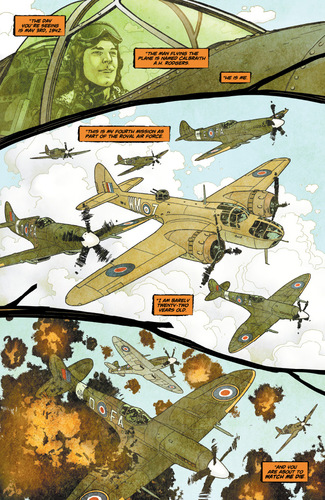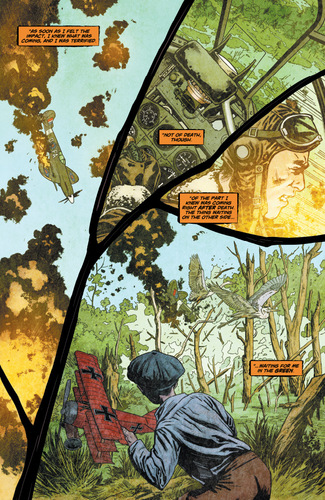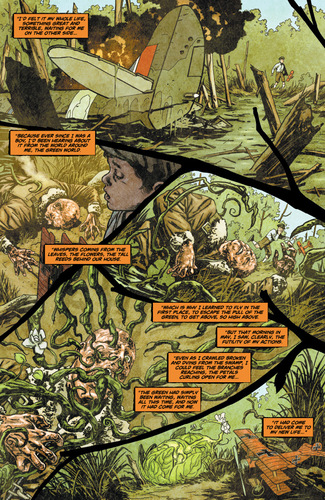When it was announced that DC Comics was going to be relaunching all of their titles with new first issues, I was wary. Most of these titles and characters have been around longer than I've been alive and I've been invested in their stories for as long as I could remember. Would rebooting it all completely discount everything I'd come to love about the characters over the years?
Relief washed over me when it was announced that Scott Snyder (American Vampire, Detective Comics, and the criminally underrated Voodoo Heart) would be taking the helm on Batman. If there's one thing I know about the redoubtable Mr. Snyder, it's that if there is anyone on this Earth who cares about the Batman mythos as much as I do. He might be one of the most astute students of Gotham's history the world has ever known and the mantle of the Bat couldn't be in any better hands. He has a contagious enthusiasm for the characters and their rich history that you can't help but get caught up in. And it's not a publicity act that he puts on because he happens to have the job. The first time I talked to Scott was the week before the first issue of the now-bestselling American Vampire came out and while the idea of writing words in the mouth of Batman was something less than a twinkle in his eye. After the formal interview, our conversation devolved into an hour long conversation about Batman, the myths, the stories, and what we both loved so much about it.
When Scott was brought on to write Detective Comics, his love of the characters came shining through. His Batman wasn't actually Bruce Wayne, but Dick Grayson, the former Boy Wonder, and, unlike some writers who have taken a crack at the character, Scott actually knew how to write the difference. He created a Gotham that was adapting to a different Batman, reflecting in a Black Mirror what could hurt Dick the most. He wrote the definitive story involving Dick's tenure in the Batman costume and it was easily one of the best Batman stories I've read in a decade. It was finely layered with character and atmosphere built on a firm foundation of prior continuity, but easily accessible to readers unfamiliar with the deep history. It's no easy feat writing Dick Grayson as Batman, to write a Batman that's simultaneously scary and full of easy charm, but Scott pulled it off flawlessly. (You can preorder that run on of comics on Amazon.)
And that's part of why I'm not worried at all about how Batman will fare with DC's reboot. With this week's release of Batman (Vol. 2, Issue #1), Scott will have graduated from Boy Wonder as Batman to the original Bruce Wayne. I had few doubts that it would be incredible, but I was able to talk to Scott about what few fears I had and I haven't been this excited for a Batman book since awaiting the results in the death of Jason Todd.
Bryan Young: The first thing I want to ask is about your connection to Batman and how you feel about relaunching a book that's been going strong for decades?
Scott Snyder: Yeah, I feel honored, and I feel totally thrilled and also if I thought about it too long I'd probably get really scared and intimidated but the fact of the matter is the story that we're gonna tell in Batman is a story that I've been thinking about for a long time with Bruce and it's something I've been really working on. It's something that's been in the works for me for a while as the absolute Bruce Wayne story that I'd like to tell that has been sort of something gestating for a while. DC basically said, "Listen, you're working on certain characters here, you've got your favorite characters in front of you, you've got Batman, you've got Superman, you've got Animal man, tell us what you think the best story for this character would be, regardless of what it means for the status quo. You tell us, as fans of the character, what you would love to do if you could with your absolute favorite character." And so, for me, with Batman, this really is that story. It's the story that I would tell, whether there's a relaunch or not a relaunch cause it's a big, epic, ambitious story about Bruce and his relationship to Gotham.
I'm very grateful for DC for just giving us the chance to do the stories that we'd love to do with characters, and for some superheroes it's been exciting for the creators to get to make big changes to them. It's all out of making the best story for the character possible. For us, on Batman, it didn't really mean changing a tremendous amount you know, if you love the character and you love the story of his history and his rich past, and all the things that have been there, those things are largely intact. He's not radically altered. He is the classic tough Bruce Wayne that you know and love with all the things that you know about his history still standing. When it comes to other characters in the DCU, creators have done really exciting things with them so for us when it comes to what it feels like to relaunch the character, on the one hand, when you think about the relaunch in the abstract, it's exciting and intimidating and thrilling and all those things, but at the end of the day, when I think about the story we're telling, it's inspiring because it's the story we've wanted to tell for Batman for a while, you know with Bruce Wayne, so I feel really just thrilled to get it out there in the world and see what people think of it.
BY: You've taken over the world in popularity with your portrayal of Dick as Batman, and I know we've talked quite a lot about the differences between Dick as Batman and Bruce as Batman. Tell us about how you're approaching them differently.
SS: For me, Dick Grayson is a character who is a superhero for very different reasons than Bruce is. At the core, they're really really different men. Dick doesn't have the same baggage that Bruce does. I think in a lot of ways, he's a hero for very altruistic external reasons, out of compassion, empathy, and a need to help. Those things are there for Bruce, it's not that he's doing it completely out of some kind of selfishness but he has a more pathological drive to him and more of an obsessive quality and he's more of a loner. He's not sort of a social creature the way Dick is, and to me, their relationship and the differences between them are part of what makes them both so interesting. The relationship between Dick Grayson and Bruce Wayne is something we'll be exploring in Batman a lot, too, and the sort of destinies for both characters.
For me personally, I know that there's a lot of people think, "Well what's going to happen to Batman long in the future when he's an old man?" And I love those interpretations in Batman Beyond, Dark Knight Returns, Kingdom Come, all those books I love things that project into the future with these characters and see take them to their logical extensions and imagine these speculative stories for them.
I know a lot of people think that Clark will bring down Bruce if Bruce ever went too far they'd wind up on different sides of the fence. I really feel that Bruce would beat Clark and the person that would wind up bringing him down would actually be Dick Grayson, almost his figurative son, so that relationship is one of the richest veins in all of comics and I'm very, very interested in it in terms of the stories being very different. Detective was really about Dick facing a Gotham that was changing and adapting so it could be a more vicious enemy to him. Gotham was trying hard to convince him that his strengths were weaknesses and why he'd never be a good superhero, that's what it does. Bruce is a really different creature. The things that scare Dick don't scare Bruce.
So what this story is about in Batman: if Bruce is anything out of that kind of obsessive quality as a hero he's confident, it's all he has at the end of the day it's his being Batman. He has his alliances and friendships, but Bruce is a loner. He has the cave and he has the Bat and so what we wanted it to have Gotham really show how Bruce has gotten comfortable. Bruce has become confident, Bruce is back in Gotham, excited to fight crime, feeling great, feeling like he owns the city, it's the city of the Bat. And all of a sudden these murders begin that start to alert him to the fact that maybe he doesn't know the city as well as he thought. Maybe there's an enemy from old Gotham nursery rhymes. An ancient evil in Gotham that's been there for centuries. Because Gotham really 300 years old, no matter how long Bruce has been Batman, he's not as old as the city. So maybe the city belonged to another symbol, a rival symbol, long before it did the Bat, and maybe that sort of organization or that enemy just hasn't really been bothering with Batman until now. So what we wanted to do was really chip away at Bruce's confidence and undermine his real foundation and show that this is something he's investigated in the past, something he's decided doesn't exist, but what if it does exist somehow, what if it really is there and what would that mean for Bruce, to realize there's a huge enemy in Gotham he never even was aware of that has connections to the history of the Wayne family and the history of the Grayson family and the Drakes that's built into the very architecture of Gotham. So that's the story we're doing with Bruce, it's very different than the story we're doing with Dick but at its core it's the same approach. We want the story to be something that challenges the character to his very essence.
We want it to be about stories that really matter for these characters that define them as heroes.
BY: I think a lot of the push and a lot of the point of doing the DC relaunch is to bring new readers to the books, how did you approach Batman #1 to acclimate new readers to the character so that there's something there for them and so they don't have to read it as though they're wading in all kinds of continuity.
SS: I'll tell you first of all the best way for me to do that is to bring your love of the character to page one, meaning you, as a writer, bring all of the joy and excitement you have for that character to every page, it makes it accessible intrinsically because you develop the character on the page as a person that you love and you want to engage people the way you're engaged by them so I would say there weren't really many tricks to it in terms of that. Luckily the story I want to tell with Bruce is one giant sort of story in the form of other books I've really loved like the Long Halloween or Hush that stand as stories you can jump on at issue one and know nothing about Batman and sort of be fine with. So for us it was really designed to be accessible from go and then when the relaunch happened and it got numbered at number one I looked at it and thought, "Okay, now I'm going to have to change some stuff to be more accessible." And as I was reading it, I realized I really didn't, it has everything in issue one that, to me, introduces a new fan to the world of Batman and celebrates the world of Batman for an older fan -- the rogue's gallery, the relationships between Bruce, Dick, Tim, Damien, they're all there. The manor, the grandfather clock with the hands at 10:47 and Alfred, the Batmobile, the Batcave with all new gadgets, Commissioner Gordon -- I wanted all those things to be at the beginning of the story because it's really about Batman being comfortable, and Batman feeling excited to be in Gotham and to in control of the city. Issue one establishes the status quo of Batman, which is the classic status quo, so our story really didn't have to be changed at all to fit this kind of number one idea. At the same time I'm really excited for it to be a jumping on point for new fans because it's a story that, as much as I was excited to bring to fans of the character with tons of references and Easter eggs, it's also a story that's designed to be able to introduce new fans, like my son when he gets a little older for example. Or for it to be a the first Batman book for someone and have them be able to pick it up and say, "Oh this is why I love Bruce Wayne, why the writer likes Bruce Wayne, I can see it from the beginning." And it makes them excited and it's a good access point to the whole world and mythology of Batman.
Batman #1, written by Scott Snyder and drawn by Greg Capullo, hits comic book stores this week. If you're even half interested, I would go out as soon as possible and get a copy since DC has been selling out their titles with this new relaunch at an impressive rate.
In addition to Batman, Snyder is bringing his enthusiasm to the world of Swamp Thing. Swamp Thing is a less well-known character, but certainly no less beloved, especially after Alan Moore's iconic run on the comic. Having read the first issue, I can personally attest to Scott's understanding of the character and his ability to make it accessible to both long time fans and new readers.
Swamp Thing #1 was part of the first week of DC's new launch and met rave reviews across the board. DC Comics has been kind enough to give us a preview of the second issue, which hits stands next month.
You can read more about this and other geek-centric interviews at Big Shiny Robot!




